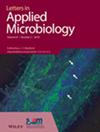将表面拭子与光学显微镜相结合,用于检测和量化不锈钢表面的细菌细胞。
IF 2
4区 生物学
Q3 BIOTECHNOLOGY & APPLIED MICROBIOLOGY
引用次数: 0
摘要
拭子取样是在各种环境表面回收微生物的常用方法。针对特定目标的成功应用取决于正确的拭子方法和后续的检测方法。在此,我们评估了影响表面拭子取样的关键因素,旨在实现光学检测对不锈钢表面细菌细胞的最佳检测和定量性能。结果表明,使用碳酸氢氨湿润的聚氨酯泡沫拭子轻轻采集,然后在 NH4HCO3 溶液中超声辅助释放,10×10 cm2 不锈钢表面肠炎沙门氏菌(SE1045)细胞的回收率高达 92.71±2.19%。在六种不同的泡沫拭子中,Puritan™无菌大号泡沫拭子与光学检测分析法结合使用时,背景噪音最低,回收效率最高。值得注意的是,我们的方法在检测到的细胞数和表面上播种的 SE1045 细胞的理论数(104-107 CFU)之间表现出很强的线性关系(r2 = 0.9983),检测限为 7.2×104 CFU 100 cm-2。这一整合在 2 小时内完成,显示了在各种环境下的适用潜力。本文章由计算机程序翻译,如有差异,请以英文原文为准。
Integration of surface swab with optical microscopy for detection and quantification of bacterial cells from stainless-steel surfaces.
Swab sampling is a common method for recovering microbes on various environmental surfaces. Its successful application for a specific target depends on the proper swab method and the following detection assay. Herein, we evaluated critical factors influencing surface swab sampling, aiming to achieve the optimal detection and quantification performance of optical detection for bacterial cells on stainless-steel surfaces. Our results showed the recovery rate of Salmonella enterica (SE1045) cells from the 10×10 cm2 stainless-steel surface reached up to 92.71±2.19% when using ammonia bicarbonate-moistened polyurethane foam swabs for gentle collection, followed by ultrasound-assisted release in NH4HCO3 solution. Among the six different foam swabs, the Puritan™ Sterile Large Foam Swab contributed the lowest background noise and highest recovery efficiency when integrated with the optical detection assay. Notably, our method exhibited a strong linear relationship (r2 = 0.9983) between the detected cell numbers and the theoretical number of SE1045 cells seeded on surfaces in the range of 104-107 CFU, with a limit of detection of 7.2×104 CFU 100 cm-2. This integration was completed within 2 hours, exhibiting the applicable potential in various settings.
求助全文
通过发布文献求助,成功后即可免费获取论文全文。
去求助
来源期刊

Letters in Applied Microbiology
工程技术-生物工程与应用微生物
CiteScore
4.40
自引率
4.20%
发文量
225
审稿时长
3.3 months
期刊介绍:
Journal of & Letters in Applied Microbiology are two of the flagship research journals of the Society for Applied Microbiology (SfAM). For more than 75 years they have been publishing top quality research and reviews in the broad field of applied microbiology. The journals are provided to all SfAM members as well as having a global online readership totalling more than 500,000 downloads per year in more than 200 countries. Submitting authors can expect fast decision and publication times, averaging 33 days to first decision and 34 days from acceptance to online publication. There are no page charges.
 求助内容:
求助内容: 应助结果提醒方式:
应助结果提醒方式:


